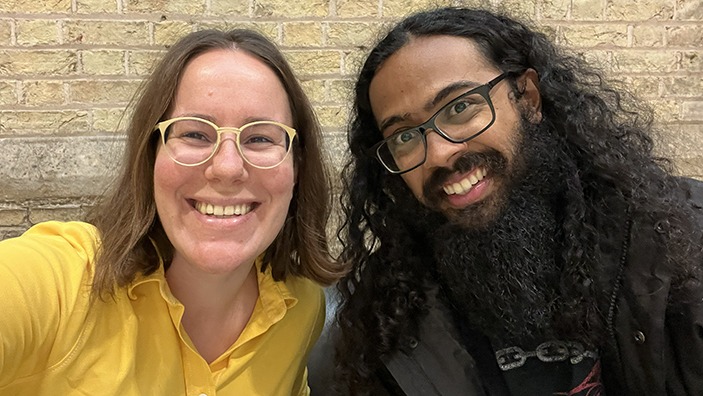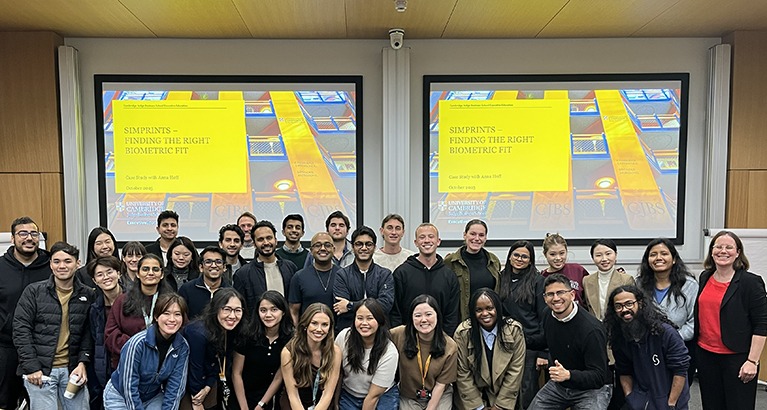
Addressing his MBA class on Business and Sustainable Development, Professor Matthew Grimes shows on big screens a classic image from the 1931 film Frankenstein, the scene when Mary Shelley’s disturbing and uncertain creation was brought to life, to underline how innovation and impact involve far more than simply failing fast and breaking things.
Impactful innovation for startup firms isn’t just about creating something to see how it plays out, says Matthew, Professor of Entrepreneurship and Sustainable Futures at Cambridge Judge Business School. Instead, entrepreneurship that has an important impact on society often involves crucial decisions and very difficult trade-offs that set the future course for a young firm.
Simprints helps provide health and other records in developing countries
To illustrate how such decisions and trade-offs are navigated, the recent guest lecturer for Matthew’s class was Anna Hoff, an Executive MBA alumna of Cambridge Judge Business School (EMBA 2019) who as part of her EMBA programme co-authored a case study about Simprints, a 10-year-old firm that supports local systems to develop digital record-keeping systems for individuals who lack formal documentation such as birth certificates.

“It was really fantastic to return to Cambridge Judge and use the case study that was part of my EMBA programme to help teach today’s MBA students on sustainable development issues in business,” says Anna, Senior Electrical Engineer at Ford Motor Co. in Germany, who has worked for 17 years in the automotive sector. “The Simprints case is a really instructive example of the choices facing firms as they seek to scale up to solve pressing social problems while also ensuring their own long-term viability.”
Simprints was co-founded in 2015 by Toby Norman, a PhD graduate of Cambridge Judge (PhD 2011). The case study – entitled Simprints: finding the right biometric fit – was co-authored by Anna Hoff, Cambridge Judge Professor of Marketing Jaideep Prabhu (who was Toby Norman’s PhD supervisor), and Krathika Parchani and Sarah Grieves who are now Simprints alumni.
“If you can’t see where the problems are you can’t fix them,” Anna tells the class of a guiding principle of Simprints, which uses fingerprints and facial biometrics to help identify about 850 million people around the world whose lack of formal records hinders administration of health care and other services in developing countries. A Simprints engineer, Anindya Sharma, demonstrated how the technology works, explaining that the firm is moving quickly toward facial biometrics owing to the ubiquity of smartphones.
Key question for Simprints: how much to customise its products
Anna outlines for students the mission of Simprints and the issues facing the company as it sought around 2020 to scale up to impact even more people around the world. One key issue is that governments often seek ownership and control of key information and programmes such as health care, so those governments want Simprints to customise its product. But it is far easier and less expensive for Simprints to scale up using a non-customised template. So what’s a young company to do in order to maximise reach and impact while also ensuring the future of its business model?
If you can’t see where the problems are you can’t fix them.
As outlined in the case study, Simprints had 4 key options in setting future strategy:
- only accept projects that used its standard products
- a mix of customised and standardised projects
- moving to open-source technology
- adopt a hybrid approach
The Co-Founder and Chief Strategy Officer of Simprints, Alexandra Grigore, explained the financing angle in a live video feed to the class: “The way the funding model works in international development is that you have a funder and they usually fund a specific project in a country, but there are very few predictable funding cycles.”
Customisation issue can serve R&D function for startups
Matthew, who last year authored a study on how unicorns (private companies valued at US$1 billion or more) can develop more responsible entrepreneurship, told the class that the focus on whether and how much to customise at Simprints holds broader lessons for enterprises seeking to scale.
“Customisation to various degrees can become a startup’s R&D (research and development) lab”, he says, because it allows the company to experiment on the optimal degree of customisation. “If customisation is the only way chosen, then smaller projects could be pushed aside because a company wouldn’t be able to afford customising every product.”
Related content
“Cambridge Judge Business School launches new Case Study on Simprints.” Simprints.com, 11 November 2025






